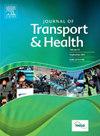Influences of built environment on the use of urban greenways: A case of Qinghe greenway, Beijing
IF 3.3
3区 工程技术
Q2 PUBLIC, ENVIRONMENTAL & OCCUPATIONAL HEALTH
引用次数: 0
Abstract
Introduction
Due to the significant health and social benefits of greenways, developing effective planning and design strategies to promote greenway use is an important concern in urban research and practice. Most previous studies have examined greenways from various regions or cities, which might face challenges in controlling for surrounding regional factors. Furthermore, the refined design factors rather than overall features of built environment along urban greenways have been rarely studied.
Methods
This study selected the case of the Qinghe greenway in Beijing, which is an ideal case for controlling regional factors due to its notable segmental differences within one single greenway. We collected 264 valid questionnaires from greenway users, and performed regression models to investigate the influences of personal factors, greenway design factors, and road access factors on three independent variables: the total weekly duration of greenway use, the frequency of greenway visits, and the average duration per visit.
Results
The results revealed that users who travel longer distances to the greenway tend to spend more time on the greenway. The length and width of the greenway, and the presence of natural riverbank are significantly associated with greenway use. Users who access the greenway via arterial roads, living streets, and lanes spend less time on the greenway than those who use internal road access.
Conclusions
To improve the greenway use, more attention should be paid to building continuous, wide and natural greenway sections. Additionally, opening up more internal roads that directly connect to greenways in nearby communities could also help increase greenway use.
建筑环境对城市绿道使用的影响——以北京市清河绿道为例
由于绿道的巨大健康和社会效益,制定有效的规划和设计策略来促进绿道的使用是城市研究和实践中的一个重要问题。之前的大多数研究都考察了不同地区或城市的绿道,这可能会面临控制周围区域因素的挑战。此外,对城市绿道沿线建筑环境的精细化设计因素的研究较少,而对其总体特征的研究较少。方法以北京市清河绿道为例进行研究,该绿道在单个绿道内存在明显的分段差异,是控制区域因素的理想案例。本研究收集了264份绿道使用者的有效问卷,通过回归模型分析了个人因素、绿道设计因素和道路通道因素对绿道每周使用总时长、绿道使用频次和平均使用时长三个自变量的影响。结果研究结果显示,到绿道的距离越远,用户在绿道上花费的时间越长。绿道的长度和宽度以及天然河岸的存在与绿道的使用密切相关。通过主干道、生活街道和车道进入绿道的用户比使用内部道路的用户在绿道上花费的时间更少。结论要提高绿道的利用率,应注重建设连续、宽阔、自然的绿道路段。此外,在附近社区开辟更多直接连接绿道的内部道路也有助于增加绿道的使用。
本文章由计算机程序翻译,如有差异,请以英文原文为准。
求助全文
约1分钟内获得全文
求助全文

 求助内容:
求助内容: 应助结果提醒方式:
应助结果提醒方式:


